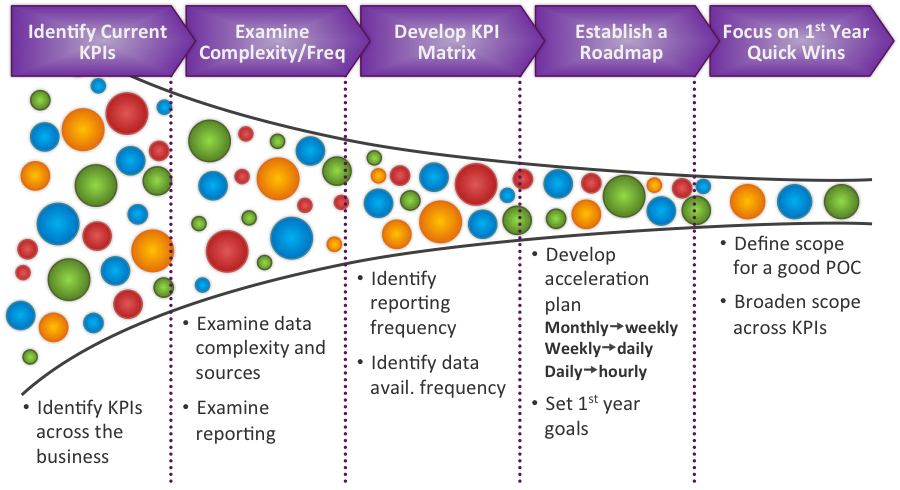
20 Apr From 50 KPIs to 10: Moving from Static to Real-time KPIs – Part II, Some Random Thoughts
Still our most popular post, we discussed moving from static to real-time Key Performance Indicators and a methodology we use to help achieve real-time KPIs. Executing a static to real-time KPI transformation does not need to be a daunting task, when executed in a methodological manner. Here are three random thoughts for organizations to consider when considering such an initiative.
Identification of the KPIs
Identification is more than just creating a list – we do not want to be using Post-its on our monitors. To identify KPIs in a manner conducive to a real-time transformation, organizations need to develop a hierarchical taxonomy. This is a fancy term to indicate a grouping of KPIs from a strategic level all the way to a very specific level.
Let’s use an example of a KPI we see in use all the time: On-Time-in-Full (OTIF). This KPI can be included within a subset of KPIs in Customer Service and in Finance. Supporting KPIs which may fall underneath OTIF can include schedule adherence, work-order variance, % On time.
Level I KPI Grouping: Customer Service
Level II KPI: OTIF
Level III Supporting KPIs: Schedule Adherence, Work-order-variance, % On time
Consistency of experience
Hopefully, we are done with paper reports – by the time a report is printed, the information, and more importantly, any actions may be obsolete. As the workforce has become more mobile, we also cannot think of propagating information such as KPIs in “mobile-only” manner. We need to support and embrace numerous forms of communication and propagation of information – mobile, smartphone, tablet, laptop, desktop, printed report. Yes, a printed report is still ok, as long as the report is included in a consistent set of experiences.
Review Frequency and the impact on the business.
“Review Frequency” – this item sound obvious, but many times, we see IRFS – Inconsistent Review Frequency Syndrome. IRFS is the phenomenon where a crucial KPI or group of KPIs is still reviewed formally, but the with differing time table:
“We sometimes review OTIF daily, sometimes weekly, sometimes monthly.”
This can be a valuable discussion where the organization decides to enforce a practice of reviewing such KPIs on a weekly basis. This is a good outcome – applying discipline to the review process. With an optimal review frequency, we have another puzzle piece for a static to real-time KPI transformation. Even better is turning “review meetings” into action meetings. Review the data on your time… ahead of time and focus the meeting on actions.
There you have it – three random thoughts:
- When reviewing KPIs, be organized
- The experience must be consistent across all platforms and devices
- Reviewing the frequency and focusing on action can yield interesting results
[optin-monster-inline slug=”qloggraxd3payfghmxer”]


